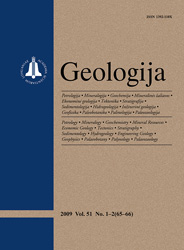Geologija / Geology
WHAT?
 ISSN 1392-110X ISSN 2029-056X (online) |
2007 m. Nr. 3 The geochemical and geoecological situation in the areas
of the Skagerrak and the Baltic Sea where chemical
munition was dumped
Kravtsov, Paka, 2000; Paka, Spiridonov, 2002; Paka, 2004; Emelyanov, Kravtsov, 2007 investigated the geological structure and geoecological situation in all three areas of chemical munition (CM) dumping. In this paper, we shortly describe the first two sites. The results of geochemical, hydrochemical and geoecological research are presented. The geological structure of the sites where chemical munition (CM) had been dumped is more or less simple, glaciomarine, the bottom is somewhat inclined, with some steps on the bottom in the Skagerrak (depth 180–220 m), and flat (horizontal) in the Bornholm Deep. The bottom is covered mainly by mud (thickness about 1–3 m) in both areas. However, in both sites there are places where the thickness of the Holocene mud is strongly reduced or the mud cover is fully absent. The strong nearbottom currents in these places are able to resuspende the mud and redeposit it. In those places in the Bornholm Deep (depth 80–105 m), on the bottom surface hard moraine or lake clay is lying. The shells and bombs at these places are rolling and are able to move very far from the dumped areas. The upper layer (0–5 cm) of the mud contains up to 6.29% of Corg., 0.35% of P, 0.72% of Mn and up to 227 ppm of As. The contents of all the other toxic elements studied (Pb, Cd, Hg, Cu, Zn) are in the Clarke (mean) concentrations (see Tables 1–8). Arsenic, as one of the most toxic elements, is released during hydrolysis of CM and disperses in the mud up to average contents of 10–30 ppm. Overclarke contents of this element are concentrated in iron sulphides (up to 440 ppm of As) in the stagnant environment or in the iron–manganese nodules or crusts (up to 1021 ppm of As) in the oxic zone. No signs of the distribution of dispersed arsenic from dumped CM areas over the whole Bornholm Deep were detected. This element is concentrated in some places near sunken warships with CM. According to our data (Emelyanov, Kravtsov, 2007), the background concentrations of As in the mud and its over-concentrations in sulphide and iron-manganese nodules are not ecologically dangerous to man. They are not dangerous for building in the future cable lines and pipelines on the bottom outside of the conventional areas of dumped CM, and these lines will not stimulate CM hydrolysis and the distribution of arsenic over the Bornholm Deep. Keywords: Baltic Sea, Skagerrak, Bornholm, buried chemical munition, geochemistry of sediments, geoecology |
Issues:
2011 - Vol.53 No. 1, No. 2, No. 3 2010 - Vol.52 No. 1-4 2009 - Vol.51 No. 1-2, No. 3-4 2008 - Vol.50 No. 1, No. 2, No. 3, No. 4, No. Priedas 2007 No. 1, No. 2, No. 3, No. 4 2006 No. 1, No. 2, No. 3, No. 4 2005 No. 1, No. 2, No. 3, No. 4 2004 No. 1, No. 2, No. 3, No. 4 2003 No. 1, No. 2, No. 3, No. 4 2002 No. 1, No. 2, No. 3, No. 4 2001 No. 1, No. 2, No. 3, No. 4 |